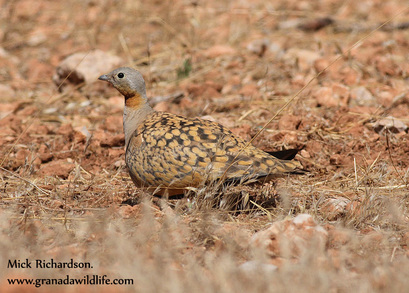The Birds.
Due to the many different habitats locally we are fortunate to have the wide variety of birds that go along with them. In the mountains we pick up all the species that would be expected in the Andalucía Sierra's including Rufous-tailed Rock Thrush (Monticola saxatilis), Black (Oenanthe leucura) and Black-eared Wheatears (Collalba Rubia / Oenanthe hispanica), Rock Bunting (Emberiza cia), Rock Sparrow (Petronia petronia) and the stunning Eagle Owl (Bubo bubo).
On the fields and Agricultural areas we are very lucky to still have quite a few nice species in good numbers including Little Bustard (Sisón Común / Tetrax tetrax) which both breed here and form flocks during the winter some times several hundred strong, Stone Curlews (Burhinus oedicnemus) which can number 600 + during the winter, smaller numbers of Black-bellied-Sandgrouse (Pterocles orientalis) and several species of Lark including Calandra (Melanocorypha calandra), Crested (Galerida cristata), Thekla (Galerida theklae), Short-toed (Calandrella brachydactyla), Sky (Alauda arvensis) and until very recently a small population of Duponts (Chersophilus dupontii).
The wetlands and Lagoons are some of the most productive areas with wintering bird numbers in the tens of thousands. Huge flocks of Greater Flamingo’s (Phoenicopterus ruber) are joined by a few pairs of the very rare Lesser Flamingo (Phoenicopterus minor) during the wetter parts of the year and if the water levels are good they stay to breed and with up to 30 thousand of the former and 3 / 4 pairs of the latter it is quite a spectacle. Other uncommon water birds include White-headed (Oxyura leucocephala) and Ferruginous Ducks (Aythya nyroca) and occasional Marbled Teal (Marmaronetta angustirostris). Heron species are well represented with all the common birds being found in the area along with some of the more difficult like Little Bittern (Ixobrychus minutus), Great White Egret (Egretta alba) and Glossy Ibis (Plegadis falcinellus) turning up regularly. Also there are a good number of wintering Common Cranes (Grulla Común / Grus grus) which are usually easy to see out on fields surrounding some of the wetlands. |
Raptors are also seen regularly with resident pairs of Bonelli's (Hieraaetus faciatus) and Golden Eagles (Aquila chrysaetos) along with the summer visiting Booted (Hieraaetus pennatus). Smaller species include good populations of Montagu's (Circus pygargus) and Hen Harriers (Circus cyaneus), Lesser Kestrel (Falco naumanni), Peregrine Falcon (Falco peregrinus), Merlin (Falco columbarius) and during passage the odd Hobby (Falco subbuteo) and Eleonora's Falcon (Falco eleonorae). These are joined by Black Kite (Milvus migrans), Common (Buteo buteo) and Honey Buzzards (Aberjero Pernis apivorus) and Griffon Vulture (Gyps fulvus).
Lower down in the Oak and Pine woodlands passerines abound, some of the most interesting are the Warblers with Orphean (Sylvia hortensis), Subalpine (Sylvia cantillans), Dartford (Sylvia undata), Spectacled (Sylvia conspicillata) and Bonelli’s Warblers (Phylloscopus bonelli) all being seen regularly. Golden Oriole (Oriolus oriolus), Southern Grey (Lanius meridionalis) and Woodchat Shrikes (Alcaudón Común / Lanius senator), Short-toed Treecreeper (Agateador Común / Certhia brachydactyla) and Crested Tit (Herrerillo Capuchino /Parus cristatus) keep the birders eye keen. The area also attracts very good numbers of waders, resident species include Black-winged Stilt (Himantopus himantopus), Avocet (Recurvirostra avosetta), Kentish Plover (Charadrius alexandrinus) and other. During the passage periods anything can turn up but some of the regulars are Curlew Sandpiper (Calidris ferruginea), Red Knot (Correlimos Gordo / Calidris canutus), Temmincks Stint (Correlimos de Temminck / Calidris temminckii) and Marsh Sandpiper (Archibebe Fino / Tringa stagnatilis).
In some years Crake species can be seen in good numbers with Little (Porzana parva), Baillon’s (Porzana pusilla) and Spotted Crakes (Polluela Pintoja / Porzana porzana) all passing through, some rarely staying on to breed. Other species of interest not mentioned above are Great Spotted Cuckoo (Clamator gladarius) which are regular from mid February onwards, Roller (Carraca / Coracias garrulus), European Bee-eater (Abejaruco Común / Merops apiaster), Eurasian Scops Owl (Otus scops) which can be heard in many places, Red-necked Nightjar (Caprimulgus ruficollis) which call from late April right through the summer, Penduline Tit (Remiz pendulinus) which regularly winter down on the coastal wetlands and many many more. Obviously the species seen on a tour will be dependent on the time of year and the weather !
View my bird web album here. |
© of all Photographs and text on this web site and the blog belong to Mick Richardson and Granada Wildlife 2009/19.
Responsabilidad Civil (Public Liability Insurance) by Ocaso.
Responsabilidad Civil (Public Liability Insurance) by Ocaso.










